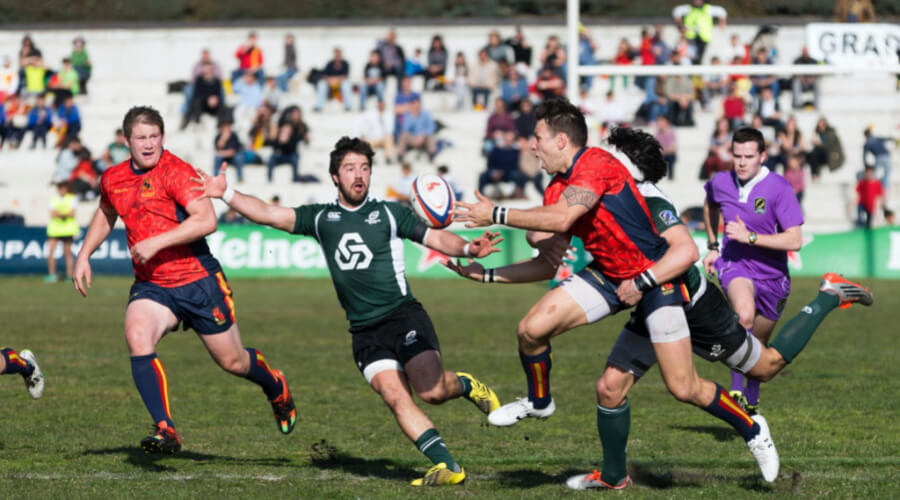Last Updated on October 9, 2023 by Alex PT
Australian Football and Rugby are distinct sports. Australian Football, unique to Australia, features oval-shaped fields, kicking, and high-scoring. Rugby, including Rugby Union and Rugby League, uses a rectangular field, more tackling, and different scoring rules, with global popularity.
Comparison Table – Rugby Vs Australian Football
The table below contains the major differences between rugby and Australian football.
| Parameters | Rugby | Australian Football |
| Field Size | 100 meters long and 70 meters wide | 185 meters long and 155 meters wide |
| Field Shape | Rectangular pitch | Unique Oval |
| The shape of the ball | Egg-shaped with a smaller hump | Egg-shaped with a larger hump |
| Number of players | 15 players on the field | 18 players on the field |
| Substitution | A total of 7 substitutions | A total of 3 substitutions |
| Length of the game | 2 halves40 minutes each | 4 quarters20 minutes each |
Australian Football VS Rugby – The Differences

We’ve listed the main differences between rugby and Australian football. Let’s check them out!
The Shape Of The Field
Not only the rules but also the shape, of both rugby and Australian Rules Football are different. In Rugby, a rectangular pitch is used, instead of an oval one in AFL.
The Size Of The Field
The rugby field in standard measurements is 100m long and 70m wide, with goalposts both set at the two opposite ends of the fields that are 10m wide by 7.3m high. The size of an AFL field varies from stadium to stadium and can vary in terms of length and width. For instance, for an AFL ground to be certified for competitions, the minimum length required is 135-185m with a width varying from 110 – 155m. This means that in terms of surface area, an AFL field may vary over time but it will more than likely be bigger than a rugby field.
The Shape Of The Ball
NFL footballs are easily distinguished from rugby, but American Footballs used in matches played in the Australian Football League are hard to differentiate from rugby. Both sport egg-shaped orbs, but compared to rugby, AFL balls seem to have larger humps. Also unlike most Rugby, they have laces which make them easier to run around with and catch and receive passes that are a part of the game.
The Number Of Players And Substitutions
In standard Rugby football, a sport originating in England but spread to other countries including America, a team consists of 15 people on the field, and a total of 7 substitutions are allowed during one match (or “game”). In Australian Football League or Aussie Rules, as it’s better known, there are 18 players per team and only three replacements for players who leave the field. Because there are more players in Aussie football than in Rugby, fewer subs are allowed: only three.
The Length Of The Game

Although the game and the duration are the same for each of these sports, 80 minutes in length, they are played in different ways. In rugby, there are two halves or 40 minutes total time on the clock. In Australian Rules Football, however, there are quarters that last 20 minutes in total per quarter. The second quarter ends when time runs out on the clock.
The Rules: Scoring
Finally, there are different ways to score as an Aussie rules football team. In rugby, the ball has to be considered “carried” into the in-goal area. The team who is able to do so is rewarded 5 points. In AFL, however, there are two ways to score. One of the most common ways to score is by kicking the ball between goalposts and into ‘the onion bag’ which stands at ground level (this could also include behinds if you’re successful). This is worth 2 points.
The other way a goal can be scored in AFL is by directly kicking or carrying the ball between goalposts but this isn’t as common a practice as in Rugby and so carries no value, but what it does accomplish is getting you a lot closer towards another point-scoring opportunity. This kind of goal-scoring approach is referred to as a conversion in Aussie Rules Football because it converts how you might have otherwise scored or failed on that given kick had it been made differently.
The kicking team gets 1 point if the ball goes through the outer posts. We call this a “behind.” If the ball goes through the inner goalposts, that’s called a “goal” and the kicking team gets 6 points. These posts are not of comparable size, so it is common for AFL clubs to install only Australian-made goalposts that are suited for this specific sport. They don’t make much sense if you try to use your American ones instead LOL!
The Rules: Passing And Tackling
In both games, each set of rules regarding scoring, gameplay, and advancing the ball are different. For example, in American football players can only throw or punt the ball forward while things like setting up scrimmage occur at a line before going on to kick or dive for a cheerfully deflated pigskin called a “football”.
Everything about rugby is pretty awesome, but my favorite part of the way it’s played compared to other sports is that a tackle doesn’t necessarily mean the end of a play. The same goes for AFL, but someone can tackle players in this game without hurting them too badly by putting pressure on the ball rather than trying to bring the player down entirely. Although rough tackles do happen from time to time in both AFL and rugby, tackles don’t tend to be quite as harsh as those in many other contact sports.
Offside
The Australian Rules football has no offside restrictions. Aussie rules players have total freedom to explore the field, and can typically start at any section of the field. This permits a dynamic offensive style in which Aussie rules players are given numerous possibilities to interact with teammates and advance the ball upfield, placing them in a position from where they can score more easily than their opponents.
In rugby, unlike Aussie rules football, there are strong offside restrictions. With Rugby’s offside rules (meaning: you cannot cross your opponents’ ‘half line’ if 3 or more players are between you and the try line), it’s better for a rugby team to attempt long drop-goals than field goals. Meaning, success is often associated with either scoring lots of tries to win big numbers of points or scoring 1-3 points per match by making very difficult shots at goal.
To score a goal, the kicking team should have been behind the kicker when the ball was kicked. The absence of offside means that Australian rules football is pretty much a kicking demo. You may kick the ball 30 meters up the field to another member of your team.
The difference between rugby, Australian football, and American football
| Aspect | Rugby | Australian Football | American Football |
|---|---|---|---|
| Ball Shape | Oval | Oval | Prolate spheroid |
| Number of Players | 15 per team (Rugby Union) or 13 per team (Rugby League) | 18 per team | 11 per team (NFL) or 12 per team (Canadian Football) |
| Playing Field | Rectangular field with dimensions varying (Rugby Union) or rectangular field with fixed dimensions (Rugby League) | Oval-shaped field with varying dimensions | Rectangular field with fixed dimensions |
| Scoring Methods | Try (5 points), Conversion (2 points), Penalty Kick (3 points), Drop Goal (3 points) | Goal (6 points), Behind (1 point) | Touchdown (6 points), Field Goal (3 points), Extra Point (1 or 2 points), Safety (2 points) |
| Forward Pass | Not allowed, except in Rugby League | Not allowed | Allowed |
| Protective Gear | Minimal, typically just mouthguards and light padding | Mouthguards, no helmets or pads | Helmets, shoulder pads, padding, and various protective gear |
| Tackling | Wrapped tackles, no blocking or charging | Tackling, bumping, and shepherding | Tackling, blocking, and various forms of contact |
| Game Duration | 80 minutes (Rugby Union) or 80 minutes (Rugby League) | 4 quarters, each 20 minutes (AFL) | 4 quarters, each 15 minutes (NFL) or 12 minutes (Canadian Football) |
| Possession Rules | Possession can change frequently through tackles and turnovers | Possession changes through disposals and turnovers | Possession-based, with downs and yards gained |
| Substitutions | Unlimited, with specific substitution rules | Limited, with rotations | Limited, with rotations and specific substitution rules |
| Popular Countries | England, New Zealand, Australia, South Africa, etc. | Australia | United States, Canada |
Conclusion
We have looked at all the differences between Australian rules football and rugby. In rugby, you can score by kicking a goal, whereas in Australian rules you score by getting the ball over the line.
The rugby game is made up of two 40-minute halves, whereas an Aussie rules game consists of four quarters each twenty minutes long. One of the main differences between rugby and Australian Rules football is that the former is played on a rectangular field whereas the latter one has an oval shape.
A rugby ball is slightly wider than an Australian rules football and is also much longer, about 72 to 76 centimeters for a rugby ball as compared to 63 to 68 cm for an Australian rules football. In rugby, it’s possible to play players from the opposition offside bypassing or kicking a ball behind their backs but not in the case of Australian Rules.
References:
https://www.finglobal.com/2017/11/21/difference-between-rugby-australian-football-and-american-football/
https://www.quora.com/What-are-some-major-differences-between-rugby-and-Australian-football

Hi! I’m Alex PT. I hold a Bachelor’s degree in Sports Management from Indiana University and have over seven years of valuable experience working in a Sports Event Management Company. I founded SportBlurb with the passion for bringing you the latest, most insightful, and engaging content in the world of sports. So, whether you’re a die-hard fan or want to stay informed, I’ve got you covered!

